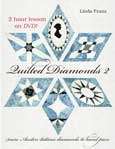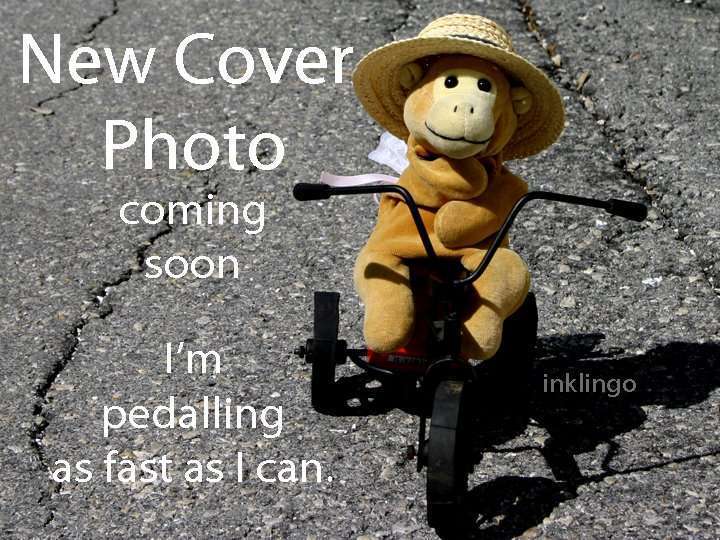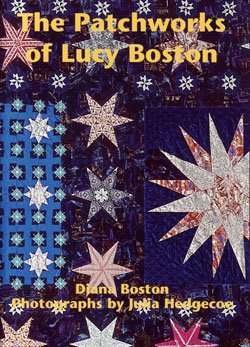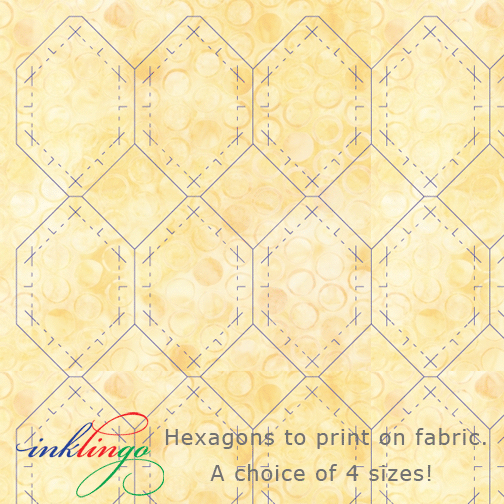Freezer paper + acrylic edge! It works for ANY SHAPE—triangles, hexagons, anything you can draw or print!
- Have as many as you want!
- They’re free! (Spend the money on fabric instead!)
- If you lose one, you can make another one!
- No waiting to start a project!
In Part 1, we showed you the advantages of freezer paper templates with an acrylic ruler. You don’t need acrylic templates if you have a ruler and freezer paper.
Part 2 showed you why I prefer freezer paper templates for fussy cutting.
Part 3 – SIX COOL TEMPLATE TIPS!

TIP # 1: A few quilters asked about the ruler I used in Part 1.
It is an ordinary acrylic ruler, but I positioned a strip of colored masking tape on the underside along the 0.25-inch line. Then, I turned it over and trimmed off the excess masking tape. You can add additional layers if you prefer.

TIP # 2: So far, just like shapes you would cut with acrylic hexagons, there are no sewing lines marked, but you can add the sewing lines with a thin ruler and a mechanical pencil if you wish.
Whenever you use templates, use ones without seam allowances so you don’t have to sew dot-to-dot.
I position the fabric on the wrong side up on the ironing board when the designs show well enough for fussy cutting, as shown in Part 2. However, if it is necessary to position the templates on the right side for fussy cutting, you will need to peel them off, reposition them on the wrong side, and repress so you can mark the sewing lines with a mechanical pencil.
Although that is a little extra work, it is still faster and easier than basting and whip-stitching for English Paper Piecing.
.
Any shape you cut with FP templates can be used with shapes you print with Inklingo.

Sew by hand or by machine.

TIP # 3: Another variation is to use clear labels with an acrylic ruler instead of freezer paper with an acrylic ruler for templates!
This is one of the template tips I shared in the two-hour video in Quilted Diamonds 2. The book is $29.95 (including the DVD), but it will save you from buying acrylic templates ever again! Sew by hand or by machine!

TIP # 4: Don’t fuss too much about fussy cutting the designs with mechanical precision!
These examples of Lucy Boston’s blocks are also in the book. They will help you relax.
The charm of some of Lucy Boston’s fussy cutting (above and below) is that there are variations.

You will notice the differences if you look at the close-up detail of her hexagons and squares in the book. All of the examples in the book have little variations like the ones above.
Lucy Boston was an artist who created exquisite quilt tops with a very limited choice of fabric. She pioneered fussy cutting for the rest of us.
This wonderful book by her daughter-in-law, Diana Boston, shows all of her quilts, including ones with fussy cutting.
TIP # 5: I like to store window templates in plastic page protectors so I can audition fabric in the quilt shop to see if the scale of the design is suitable for the shape and how much waste there will be.
Of course, printing the shapes on fabric (or paper) with Inklingo and rotary cut several layers at a time is easier and more precise.
Main Lucy Boston Page for video!
TIP # 6 Skip templates entirely!
There are step-by-step instructions and a new VIDEO on the Inklingo Beginner’s Page.
ARE YOU SUBSCRIBED?
Are you a member of the Inklingo POTC Facebook Group? Please post photos of your POTC blocks there.
When you can’t use Inklingo, use freezer paper!
Linda & Monkey
![[]](https://www.inklingo.com/wp-content/uploads/2011/04/inklingo-heart.png)







Thanks for the tip, Judy! I stopped using sandpaper after a few scratched surfaces, including a favorite pair of sunglasses that were in my traveling sewing kit when I was teaching classes. If you remember to keep the rulers separate, it works well.
Love the masking tape idea. I’ve use 1/4″ pieces of press on sand paper on most of my rulers. It grabs the edge of the fabric easily and doesn’t allow it to shift. I never need to measure less than 1/4″ and having it at the edge of the ruler guarantees that the ruler won’t shift when cutting. the “height” of the sandpaper allows it fit against the edge of the template (or edge of a paper pieced project) to help the accuracy of the 1/4″ edge.
Tip 6 is the best tip by far!
Thank you, Betsy! I prefer to print the shapes on fabric too. 😉 It is liberating to know we can get great results with freezer paper templates, so we have a great solution even when the shapes are not available from Inklingo. I hope you are having a wonderful week to sew!
Oh, Linda, you’ve done it again!! Why in the world would anyone NOT use Inklingo? I know that I would not be making POTC blocks, plus many others, without it!! Thank you so very much for making quilting so much easier, accurate, and faster with your wonderful Inklingo Method!!! I just love it!!